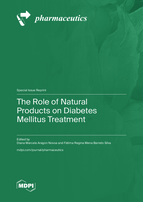The Role of Natural Products on Diabetes Mellitus Treatment
A special issue of Pharmaceutics (ISSN 1999-4923). This special issue belongs to the section "Drug Targeting and Design".
Deadline for manuscript submissions: closed (5 December 2022) | Viewed by 62226
Special Issue Editors
Interests: drug delivery; pharmacokinetics; microparticles; nanoparticles; self-emulsifying delivery; extracts standardization, bioactive compounds
Special Issues, Collections and Topics in MDPI journals
Interests: natural compounds; diabetes; infertility; cancer; central nervous system diseases; chronic diseases; medicinal plants; pain and analgesia
Special Issues, Collections and Topics in MDPI journals
Special Issue Information
Dear Colleagues,
Diabetes mellitus (DM) is a metabolic disease characterized by hyperglycemia due to secretion and/or the action of insulin or both. This disease of high incidence and prevalence affects the quality of life and productivity of the population that suffers from it. Although there are drugs that have been widely used in the treatment of this disease, at present the search for possible antidiabetic agents has continued, especially if they have more than one mechanism of action, taking into account the complexity of this pathology.
Metformin (a biguanide), which is a derivative of galegin, is among the first-line therapy for the treatment of Type II DM. This guanidine was isolated from the Galega officinalis L., a plant that has been used since the Middle Ages by diabetic patients. This fact has aroused interest in the use of medicinal plants and its secondary metabolites as possible drugs in DM treatment. Although it is difficult to find a substitute for insulin among plants, it is possible that molecules can be found that stimulate endogenous insulin biosynthesis and secretion or increase glucose absorption in blood by peripheral tissues, by acting as insulinomimetic or insulin secretagogue agents.
Following on from the above, this Special Issue is focused on the study of natural products (characterized extracts and isolated secondary metabolites) in the treatment of diabetes mellitus complications by in vivo and in vitro assays. Clinical trials are also welcome.
Dr. Diana Marcela Aragon Novoa
Prof. Dr. Fátima Regina Mena Barreto Silva
Guest Editors
Manuscript Submission Information
Manuscripts should be submitted online at www.mdpi.com by registering and logging in to this website. Once you are registered, click here to go to the submission form. Manuscripts can be submitted until the deadline. All submissions that pass pre-check are peer-reviewed. Accepted papers will be published continuously in the journal (as soon as accepted) and will be listed together on the special issue website. Research articles, review articles as well as short communications are invited. For planned papers, a title and short abstract (about 100 words) can be sent to the Editorial Office for announcement on this website.
Submitted manuscripts should not have been published previously, nor be under consideration for publication elsewhere (except conference proceedings papers). All manuscripts are thoroughly refereed through a single-blind peer-review process. A guide for authors and other relevant information for submission of manuscripts is available on the Instructions for Authors page. Pharmaceutics is an international peer-reviewed open access monthly journal published by MDPI.
Please visit the Instructions for Authors page before submitting a manuscript. The Article Processing Charge (APC) for publication in this open access journal is 2900 CHF (Swiss Francs). Submitted papers should be well formatted and use good English. Authors may use MDPI's English editing service prior to publication or during author revisions.
Keywords
- diabetes mellitus
- natural products
- secondary metabolites
- insulin secretagogue
- oxidative stress
- insulin response
- blood glucose levels
- hyperglycemia
- insulinomimetic








